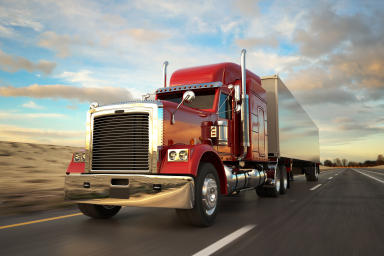The trucking industry is a big part of Connecticut's economy. It gives nearly 13,000 drivers jobs and helps more than 85% of the state's communities move their goods. There are about 8,500 trucks on major routes daily, and freight movement in the state will continue growing in the coming decades.
Even though this growth is good in many ways, it is also a serious threat to road safety. In 2021, the state had 1,548 accidents involving big trucks, which killed 31 people and hurt almost 600 others. Crashes increased by about 28% compared to the previous year. Several commercial trucking laws in Connecticut help prevent accidents and protect people's rights if they get hurt in a crash.
Connecticut Commercial Motor Vehicle Driver’s License Qualifications
Operating a truck in Connecticut requires a commercial driver's license (CDL). There are different types of CDL classes based on the type or weight of the truck. In addition, endorsements are required for drivers of commercial motor vehicles (CMVs) that transmit special cargo, such as hazardous materials.
To get a CDL, a person must:
Be 18 and above (at least 21 to drive interstate and carry hazardous materials).
Get a medical examiner's certificate from a professional certified by the National Registry of Certified Medical Examiners.
Have a commercial driver's instruction permit (CDIP).
A CDIP holder can be eligible for a CDL driving skills test after two weeks of holding a CDIP and driving under the supervision of a valid CDL holder. They must complete specific tests for the CDL class and the endorsement they need.
Speeding, texting while driving, and improper lane changes can result in 60- to 120-day suspensions. A CMV driver can be disqualified for major traffic violations like OUI and drug trafficking.
In 2017, about 17% of fatal truck accidents were caused by drivers who did not have a CDL. To drive a truck, you must know how to do it safely and have the right training. When truck drivers start driving without a CDL and the right endorsements, they endanger other people.
Connecticut Controlled Substance and Alcohol Testing for Truck Drivers
Connecticut General Statutes Sec. 14-261b requires truck drivers in the state to undergo drug and alcohol testing. Employers are required to conduct the following types of testing:
Pre-employment: A driver who fails this test should not be permitted to operate a truck or any other commercial vehicle.
Post-accident: After an accident, the CDL holder must undergo an alcohol test within 2–8 hours and a drug test within 32 hours to determine if they were under the influence of any substance at the time of the accident.
Return to duty: If the driver tested positive once, they must take further alcohol and controlled substance testing before returning as a truck driver.
Reasonable cause: A driver suspected to be under the influence of drugs or alcohol by their supervisor can be subjected to testing as long as there is proper documentation.
Random: Employers must conduct random drug testing for 50% of their drivers and alcohol testing for 25% annually.
Follow-up: If a driver is found to be under the influence of alcohol or a controlled substance, the law mandates at least six follow-up tests in the first 12 months.
If drivers refuse to submit to compulsory tests, they will be automatically deemed positive for drug and/or alcohol use.
According to a 2017 report by the US Department of Transportation (DOT), about 5% of the 4,600 large truck drivers involved in fatal crashes tested positive for at least one drug.
Connecticut Maximum Hours of Service for Truck Drivers
Connecticut follows the Federal Motor Carrier Safety Administration's (FMCSA) rule about how long CMV drivers can be on duty and how long they can be driving. The FMCSA's 49 CFR § 395.3 stipulates that:
Truck drivers must have 10 consecutive hours off duty before the start of their shift.
They must only drive up to the 14th hour after coming on duty after 10 consecutive hours off duty.
They can only drive for up to 11 hours during the 14 hours. The 11-hour limit applies whether the driver operates independently or as part of a team.
They must take a 30-minute break after driving for eight consecutive hours.
If the employing motor carrier does not operate CMVs every day of the week, the driver must not drive after 60 hours on duty in seven consecutive days.
If the employing motor carrier operates CMVs every day of the week, the driver must not drive after completing 70 hours of service in eight consecutive days.
Employers and drivers must also keep a Record of Duty Status (Log Book), which includes detailed entries of their driving time, on-duty time, and off-duty time. Additional documents, like delivery files and toll receipts, should also be available on records.
The federal rule aims to improve road safety by ensuring drivers get enough rest and stay healthy despite their hectic schedules. It aims to reduce the number of tired drivers on the road, as driver fatigue is one of the leading causes of truck accidents.
In a survey by the Sleep Medicine Division of the Harvard School of Medicine, almost half of the semi-truck drivers who participated said they had fallen asleep while on a long-haul drive. When drivers are tired and drowsy, they take longer to react, which can cause accidents that hurt or kill people.
A person in an accident involving a fatigued truck driver must contact a truck accident attorney to review their case and determine how to file claims for their injuries and damages.
Connecticut Speeding Laws
Connecticut categorizes speeding violations into several classifications, as follows:
Driving on any road at a speed that endangers the lives of others or at over 55 mph
Driving on a multi-lane limited access highway at a speed greater than 55 mph but not over 70 mph or on any other highway at more than 55 mph but not over 60 mph.
Driving on a multi-lane limited access highway at more than 70 mph but not over 85 mph or on any other highway at more than 60 mph but not over 85 mph.
Driving at more than 85 mph, regardless of the type of road
All these speeding rules apply to all drivers. However, the fine for each violation is heavier for truck drivers, which can go up to $200.
Due to the size and weight of their vehicles, truck drivers must adhere to the state's speeding laws. Their vehicles can cause significant damage in the event of an accident. When truck drivers exceed the speed limit, they endanger everyone on the road because it takes longer to stop the vehicle.
Connecticut Truck Maintenance Regulations
The Connecticut Department of Motor Vehicles (DMV) helps keep people safe by regulating cars, drivers, and companies in the transportation industry. One of its main jobs is to ensure that trucks are the right size and weight and that CMV regulations are followed. Its Motor Vehicle Inspectors are highly trained professionals with the power to make arrests.
Inspectors usually watch Connecticut highways and conduct random safety checks at six weigh stations within the state. When truck drivers pass one of the weigh stations, they must stop so their vehicle can be weighed. They have to go through a level 1 safety inspection to assess the vehicle, cargo, and driver. Once done, the truck driver will receive a report of the inspection findings. If there are any violations, they are required to address the issue within a specific period. Trucking companies that fail to comply may face fines and restrictions on operations.
In addition to the DMV's random checks, the DOT has mandatory annual inspections for CMVs such as trucks.
The inspections include six levels of safety analysis, as follows:
North American Standard Inspection
Walk-Around Driver/Vehicle Inspection
Driver-Only Inspection
Special Inspection
Vehicle-Only Inspection
Enhanced NAS Inspection for Radioactive Shipments
Trucking companies are required by law to maintain their fleets properly. Maintenance problems and equipment breakdowns in transit — such as a tire blowout, brake failure, or steering trouble — can put drivers and other road users at risk for accidents. If an accident occurs due to the negligence of a truck driver or company, victims are entitled to compensation for damages. An experienced attorney can help them file insurance claims and navigate proceedings related to trucking accident laws.
Connecticut Commercial Trucking Insurance Requirements
In Connecticut, trucking companies must acquire commercial auto insurance with liability protection at a minimum. The amount of liability coverage depends on various factors, including the vehicle’s type and value, weight, or Gross Vehicle Weight Rating (GVWR), level of risks involved, and the driver’s driving record.
The following are the required liability coverages for large commercial vehicles:
Freight vehicles of 10,001 pounds or more GVWR carrying non-hazardous materials: at least $750,000
Freight vehicles of 10,001 pounds or more GVWR carrying moderately hazardous materials: at least $1,000,000
Freight vehicles of 10,001 pounds or more GVWR carrying highly hazardous materials: at least $5,000,000
At least $1,500,000 Any commercial vehicle with a seating capacity of more than eight passengers:
Any commercial vehicle with a seating capacity of 16 or more passengers: at least $5,000,000
On top of the required liability protection, truck operators can also get additional insurance coverage for collisions, medical payments, towing, and uninsured or underinsured motorists to ensure they are fully protected in case of accidents.
If a driver needs to use a tractor without a trailer in tow, their company may consider getting bobtail coverage. This also covers the vehicle even if used during non-working hours or activities.
Some trucking companies must report to the DMV every year and send their Certificate of Liability Insurance form. These include people who drive vehicles with a GVWR of 18,001 pounds or more within Connecticut or 10,001 pounds or more that go across state lines.
Non-compliance with commercial vehicle insurance laws may result in fines and vehicle registration suspensions.
How Much Can Someone Sue for a Truck Accident in Connecticut?
The amount that individuals can recover in a Connecticut truck accident lawsuit varies from case to case and is not predefined or fixed.
However, Connecticut has no caps for both economic and non-economic damages in truck accident cases.
The state's highest motor vehicle accident verdict to date was awarded to Jorge Amparo and his wife, who obtained a total of $18.6 million in damages. Amparo sustained multiple injuries due to a truck accident involving a driver using his phone via Bluetooth when the accident occurred. His wife received a portion of the amount for loss and future loss of consortium.
Connecticut Statute of Limitations for Truck Accidents
The statute of limitations for personal injury cases in Connecticut is two years. Truck accident victims must file a claim for their injuries and damages within two years after the accident.
The two-year period also applies to wrongful death cases. However, it will start on the day the victim died, not the day they sustained injuries.
In some situations, victims can still pursue a personal injury claim even after two years from the date of the accident.
If the plaintiff's injury were not discovered during the medical exam after the accident, the filing period would be changed to start on the day the injury was found. But this type of case has a strict three-year time limit. If the plaintiff discovered the injury 20 months after the truck accident, they only have 16 months to file a claim.
The deadline can also be pushed back if the defendant is out of state or the plaintiff finds evidence that the defendant has been hiding for months.
Connecticut Is a Fault State for Insurance Claims
When it comes to truck accident insurance claims, Connecticut is a fault state. This means that if a truck driver is found to be at fault for an accident, they have to pay the people who were hurt for their losses.
The person who was hurt has three options when filing an insurance claim. First, they can file a first-party claim with their insurance company if their policy includes the right coverage. Another option is to file a third-party claim with the insurance company of the person who caused the accident. If the victim cannot get a fair settlement from the at-fault party's insurance company, they can file a lawsuit.
Connecticut Is a Modified Comparative Fault State for Trucking Accident Lawsuits
Connecticut follows a modified comparative fault system. Under this rule, the injured party is eligible for compensation as long as their share of responsibility is not more than 50%. If a plaintiff is determined to be 51% or more at fault, they can no longer recover damages.
For example, a plaintiff who was hurt in a truck accident was given $100,000 in damages but was also found to be 20% to blame for what happened. Under the modified comparative fault system of the state, they will only get $80,000 because their share of the blame ($20,000) must be taken out of the total damages.
Average Settlement for Connecticut Trucking Accident Lawsuits
The average settlement for truck accident cases in Connecticut can vary significantly depending on several factors, including the severity of injuries, damages sustained by the victims, the insurance policies of both parties and the percentage of fault of the people involved. Given the many factors that can affect the settlement amount in a truck accident case, it is difficult to provide a precise figure for the average settlement amount in Connecticut.
You should talk to a truck accident lawyer to get a better idea of how much a case will be settled for. He or she can look at the case and determine how much the claimant is to blame and how much damage has been done. Many lawyers in Connecticut take cases on a contingency fee basis, meaning clients do not have to pay their fees upfront to hire them. Instead, they get a share of the money the case brings in.
Connecticut has laws that say how much an attorney can get from a settlement for a plaintiff. The law limits their contingency fees to 33% of the first $300,000, 25% of the next $300,000, 20% of the next $300,000, 15% of the next $300,000, and 10% of amounts over $1,250,000.
Legal Resources for Connecticut Trucking Accident Victims
Connecticut Commercial Driver License Manual
This manual contains information about Connecticut trucking accident laws and regulations that commercial vehicle drivers must follow before getting a CDL and while on the road. It also has tips on how to drive safely and handle specific situations like driving a truck with air brakes, driving combinations, and transporting hazardous materials.
Sample Motor Vehicle Accident Investigation Form
It can be hard to deal with investigations after an accident, especially if the victim was hurt. It is important to keep track of the accident details so that you can help the victims with their claims. This sample accident investigation form shows what questions inspectors and insurance companies may ask people who have been in an accident.
Step into the world of Expertise.com, your go-to hub for credible insights. We don't take accuracy lightly around here. Our squad of expert reviewers, each a maestro in their field, has given the green light to every single article you'll find. From rigorous fact-checking to meticulous evaluations of service providers, we've got it all covered. So feel free to dive in and explore. The information you'll uncover has been stamped with the seal of approval by our top-notch experts.





